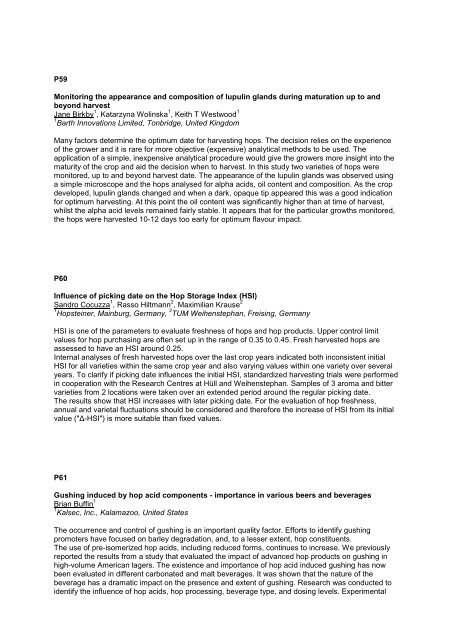here - the 34th European Brewery Convention
here - the 34th European Brewery Convention
here - the 34th European Brewery Convention
Create successful ePaper yourself
Turn your PDF publications into a flip-book with our unique Google optimized e-Paper software.
P59<br />
Monitoring <strong>the</strong> appearance and composition of lupulin glands during maturation up to and<br />
beyond harvest<br />
Jane Birkby 1 , Katarzyna Wolinska 1 , Keith T Westwood 1<br />
1 Barth Innovations Limited, Tonbridge, United Kingdom<br />
Many factors determine <strong>the</strong> optimum date for harvesting hops. The decision relies on <strong>the</strong> experience<br />
of <strong>the</strong> grower and it is rare for more objective (expensive) analytical methods to be used. The<br />
application of a simple, inexpensive analytical procedure would give <strong>the</strong> growers more insight into <strong>the</strong><br />
maturity of <strong>the</strong> crop and aid <strong>the</strong> decision when to harvest. In this study two varieties of hops were<br />
monitored, up to and beyond harvest date. The appearance of <strong>the</strong> lupulin glands was observed using<br />
a simple microscope and <strong>the</strong> hops analysed for alpha acids, oil content and composition. As <strong>the</strong> crop<br />
developed, lupulin glands changed and when a dark, opaque tip appeared this was a good indication<br />
for optimum harvesting. At this point <strong>the</strong> oil content was significantly higher than at time of harvest,<br />
whilst <strong>the</strong> alpha acid levels remained fairly stable. It appears that for <strong>the</strong> particular growths monitored,<br />
<strong>the</strong> hops were harvested 10-12 days too early for optimum flavour impact.<br />
P60<br />
Influence of picking date on <strong>the</strong> Hop Storage Index (HSI)<br />
Sandro Cocuzza 1 , Rasso Hiltmann 2 , Maximilian Krause 2<br />
1 Hopsteiner, Mainburg, Germany, 2 TUM Weihenstephan, Freising, Germany<br />
HSI is one of <strong>the</strong> parameters to evaluate freshness of hops and hop products. Upper control limit<br />
values for hop purchasing are often set up in <strong>the</strong> range of 0.35 to 0.45. Fresh harvested hops are<br />
assessed to have an HSI around 0.25.<br />
Internal analyses of fresh harvested hops over <strong>the</strong> last crop years indicated both inconsistent initial<br />
HSI for all varieties within <strong>the</strong> same crop year and also varying values within one variety over several<br />
years. To clarify if picking date influences <strong>the</strong> initial HSI, standardized harvesting trials were performed<br />
in cooperation with <strong>the</strong> Research Centres at Hüll and Weihenstephan. Samples of 3 aroma and bitter<br />
varieties from 2 locations were taken over an extended period around <strong>the</strong> regular picking date.<br />
The results show that HSI increases with later picking date. For <strong>the</strong> evaluation of hop freshness,<br />
annual and varietal fluctuations should be considered and t<strong>here</strong>fore <strong>the</strong> increase of HSI from its initial<br />
value ("Δ-HSI") is more suitable than fixed values.<br />
P61<br />
Gushing induced by hop acid components - importance in various beers and beverages<br />
Brian Buffin 1<br />
1 Kalsec, Inc., Kalamazoo, United States<br />
The occurrence and control of gushing is an important quality factor. Efforts to identify gushing<br />
promoters have focused on barley degradation, and, to a lesser extent, hop constituents.<br />
The use of pre-isomerized hop acids, including reduced forms, continues to increase. We previously<br />
reported <strong>the</strong> results from a study that evaluated <strong>the</strong> impact of advanced hop products on gushing in<br />
high-volume American lagers. The existence and importance of hop acid induced gushing has now<br />
been evaluated in different carbonated and malt beverages. It was shown that <strong>the</strong> nature of <strong>the</strong><br />
beverage has a dramatic impact on <strong>the</strong> presence and extent of gushing. Research was conducted to<br />
identify <strong>the</strong> influence of hop acids, hop processing, beverage type, and dosing levels. Experimental





